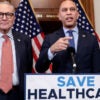Consumers may be in for sticker shock when they head to pharmacy counters not only because of across-the-board increases in the prices of prescription drugs, but also because of increasing deductibles, a trend that has been occurring for several years.
Lawmakers on Capitol Hill and health policy experts brought the debate over the rising prices of drugs to the forefront last month after Mylan, the company that manufactures the EpiPen, increased the price of a package of two epinephrine auto-injecting devices to more than $600. The EpiPen is typically used to counteract dangerous allergic reactions.
But the controversy surrounding Mylan and pricing for the EpiPen was the result of what Michael Rea, CEO of Rx Savings Solutions, called a “perfect storm.”
The lifespan of the auto-injector is one year, and as many parents prepared to send their children back to school, many purchased new packages of the devices, only to learn that the list price of a package of two EpiPens had risen to more than $608.
Much of the controversy surrounding Mylan has centered around the rising cost of prescription drugs and the factors that led the pharmaceutical company to raise the price of the EpiPen more than 500 percent over a seven-year span.
But experts say that a shift in the nature of health insurance—to plans with higher deductibles and more out-of-pocket costs—have caused consumers to feel the impact of rising drug prices more today than they have in the past.
“It’s more and more an up-front burden in terms of out-of-pocket costs falling back onto the consumer,” Rea, who is also a pharmacist, told The Daily Signal. “Part of that is because of high deductibles. Part of it is because of high out-of-pocket costs.”
“They’re not reaching that out-of-pocket max or that discounted phase as quickly as maybe they have in the past, and so in the case of EpiPen, there was also that time of year in why it sparked at the time it did,” he continued.
Kansas-based Rx Savings Solutions helps to educate consumers and employers on ways to reduce the price of prescription drugs.
At issue for consumers is the yearslong trend of increasing deductibles, the effects of which mean that patients may be forced to pay full price for medications like the EpiPen when they haven’t in the past.
A study from the Kaiser Family Foundation and the Health Research and Education Trust released earlier this month found that deductibles are increasing nearly six times faster than workers’ earnings.
Additionally, deductibles increased 12 percent from 2015 to 2016, according to the survey of employer health benefits—an increase that is four times faster than increases in premiums.
More than 150 million Americans are enrolled in employer-sponsored health insurance, and the increase in deductibles is especially prevalent among those working for firms with less than 200 people, the Kaiser Family Foundation found.
Among those employers, 65 percent of their workers are enrolled in high-deductible plans, with the average deductible at $2,000, Drew Altman, president of the Kaiser Family Foundation, wrote in The Wall Street Journal last week.
“People with high deductibles are vulnerable to sharp increases in drug prices, such as those for EpiPen that have been in the news recently,” Altman wrote.
In the wake of Mylan’s decision to raise the price of the EpiPen, the company pointed to the rise in high-deductible plans as one reason why consumers were hit hard.
“With the current changes in the health care insurance landscape, an increasing number of people and families have enrolled in high-deductible health plans, and deductible amounts continue to rise,” the company said in a statement on its website last month.
“This current and ongoing shift has presented new challenges for consumers, and now they are bearing more of the cost,” Mylan continued.
The insurance industry, however, bucked Mylan’s reasoning.
Clare Krusing, spokesman for America’s Health Insurance Plans, a trade group that represents the insurance industry, told Consumer Reports that Mylan was attempting to “distract from the company’s price increase.”
Krusing did not return The Daily Signal’s request for comment.
Still, experts say the shift to higher deductible plans has been occurring for several years and has been compounded by a change in the tiers for drug benefits.
Daniel Klein, CEO of the Patient Access Network (PAN) Foundation, said that in the past, drug benefits that were part of a health insurance plan were broken up into one or two tiers.
Today, however, there may be four or five tiers, with each one representing an increase in the amount a consumer must share in the cost.
Drugs that fall into the first tier—typically generics—require less in out-of-pocket costs from the consumer, while those that fall into the fifth tier—specialty drugs—now require a patient to pay more.
An EpiPen, for example, wouldn’t fall into the first tier, but a generic version of the auto-injector may.
“The steady increase in cost-sharing and, in particular, that tiering of the drug benefits has been responsible for people feeling a lot more pain, if you will, in terms of out-of-pocket costs,” Klein told The Daily Signal. “People who were traditionally insured and thought everything was fine and dandy are now finding they’re insured, but everything is not so easy anymore.”
The PAN Foundation assists the underinsured with paying out-of-pocket costs for prescription medicines, and Klein said his organization has seen a 10-fold increase in the number of grants they award to patients.
In 2011, the PAN Foundation awarded less than 25,000 grants to applicants needing assistance with out-of-pocket costs. In 2015, the organization allocated more than 350,000 grant awards.
Klein said the increase in grants can be attributed to an increase in the funding available to help more people, but is also a reflection of growing demand.
“People are experiencing more out-of-pocket costs for specialty drugs,” he said. “People with chronic illnesses and rare diseases, those folks are probably feeling the impact disproportionately, instead of people with a simple illness.”
In response to the backlash Mylan faced after raising the list price of EpiPens, the company announced it would be offering coupons to lower the cost for consumers to roughly $300. The pharmaceutical company also said it would develop a generic with a price half that of a package of two EpiPens.
But Rea, the CEO of Rx Savings Solutions, said the coupon is simply a Band-Aid, and he emboldened consumers to explore all options for prescription drugs.
“For 70 years, if you back up and look at the way benefits were introduced in this country, consumers were taken out of the equation,” he said. “What’s happened over time is we’ve been really passive. ‘Why do I care? It’s only $10. Why do I care? It’s only a $25 copay.’
“Now, we’ve completely flipped that upside down and now that that’s changed, we have to act like consumers.”




























